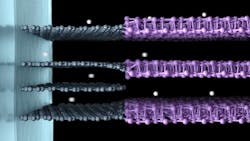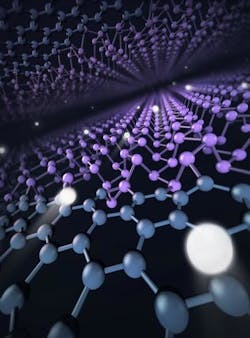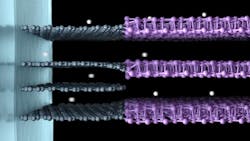Two things remain a concern for would-be electric vehicle drivers: running out of charge and the time it takes to recharge batteries. That could soon change as an international team of researchers work on a battery solution that will help waylay range anxiety fears.
When it comes to a high-capacity Lithium-ion battery that charges quickly and operates efficiently, the technology isn’t quite there yet. But a group of researchers at the University of Science and Technology of China (USTC) have developed a composite made of black phosphorous and graphite in its core and covered in electrolyte-swollen polyaniline. The engineered electrode material holds promise for industrial production, they said.
In contrast with previous efforts, the new engineered electrode material allows for a high charging rate, and the material does not sacrifice capacity and cycling stability, according to their research findings published in Science.
“The combination of high energy, high rate and long cycle life is the holy grail of battery research, which is determined by one of the key components of the battery: the electrode materials,” said Hengxing Ji, a professor at USTC.
Ji and his team said the aim of the research is to search for an electrode material that “can make a dent in performance metrics from laboratory research” and stand up to the requirements of industrial production techniques.
Energy enters and leaves the battery by electrochemical reactions in electrodes, so efficient and effective Lithium-ion transfer is of the utmost importance—especially in transferring the energy from the battery to the device via the anode, explained first author Hongchang Jin.
The researchers combined black phosphorus with graphite, as the chemical bonds between these two materials stabilized and prevented problematic edge changes. Black phosphorous has been considered for use in electrodes before but is usually abandoned due to its tendency to deform along its layered edges, making the transfer of Lithium-ions deeply inefficient and rendering a lower quality material.
Their work addressed another issue: Electrolytes can break down into less-conductive pieces and build up on the surface of the electrode, inhibiting Lithium-ion transfer into the electrode material—like dust obscuring light through glass. In this case they applied a thin polymer gel coating to the electrode materials and reinforced the Lithium-ion transport path, which prevented the issue, explained the researchers.
Vehicle Charging Potential?
Co-first author Sen Xin, professor of the Institute of Chemistry Chinese Academy of Sciences, said that the composite anode material restored 80% of its full capacity in less than 10 minutes. That translates to a 2,000-cycle operation life at room temperature, noted Xin, adding that the material was measured at conditions compatible with the industrial fabrication processes.
“If scalable production can be achieved, this material may provide an alternative, updated graphite anode, and move us toward a Lithium-ion battery with energy density of more than 350 watts-hour per kilogram and fast-charging capability,” said Xin. “Successful projection of the above parameters onto the electric vehicle will significantly raise its competitiveness against the fuel cars.”
The researchers also noted that 350 watts-hour per kilogram describes the energy capacity of the battery—an electric vehicle with such a battery could travel 600 miles on a single charge. For comparison, they point to the on-market Tesla Model S, which can travel 400 miles on one charge.
What’s Next?
The plan, according to the researchers, is to pursue both fundamental scientific questions of the Lithium-ion charging-discharging process and industry-related questions on ways to scale composite material production in more mild conditions. “We will investigate engineering materials of rationally selected structure, but with consideration for price and practicality to achieve an attractive performance,” Ji said.


